Growing hyacinths in a pot at home
Hyacinth is a plant grown outdoors in a backyard, but many gardeners, having developed a special care system, plant the plant in a pot and admire its bright flowering for a longer period. Before planting an interesting flower, it is worth learning more about its varieties and home care methods.
Content
- The best varieties of hyacinths and their features
- Soil preparation and containers
- Terms and rules for planting bulbs
- Seed propagation
- Reproduction by leaves
- Watering and feeding flowers
- Lighting, humidity and temperature
- Hyacinth care after flowering
- Possible growing problems
- Diseases and pests
- Applying colors in interior design
The best varieties of hyacinths and their features
Hyacinth is a flower that belongs to the asparagus pedigree. The plant has a pointed tube, in the center of which an inflorescence develops, dense in structure, of a green hue. Deciduous plates open over time, and the inflorescences bloom, gaining volume and a bright shade. The foliage of the bush is fleshy, smooth. Most often, the plant produces an average of 6 to 9 leaves, in the center of which a peduncle appears.
The peduncle usually grows up to 30 cm. Its structure is such that more than 2/3 of the entire perimeter is covered with large inflorescences, collected in a brush and resembling a spikelet. Usually, up to 30 pieces are located on one stem. flowers that saturate the entire area around with their aroma.
The color palette, as well as the shape of the flower, can be varied.
This is possible thanks to the various varieties that are bred under the difficult work of breeders. The color of the inflorescences can be pink, yellow, purple, blue, white or blue. After flowering, the foliage gradually dies off. The next peduncle will appear only in the new spring, in early March. Its arrow will be released from the young bud that forms on the old tuber.
Among all the varieties, 3 broad groups are distinguished, into which all varieties of hyacinths are distributed:
- Oriental
- Litvinova
- Transcaspian
Each of the groups has a significant list of varieties that have their own differences. Some are distributed according to the flowering time: early, middle and late, as well as in appearance - smooth and double. There is also a distribution by color and size of flowers, as well as to withstand frost if possible.
The table highlights the most common hyacinths suitable for indoor cultivation.
| Variety | Description |
| White pearl | The flowers are terry, whitish in color. Outwardly, they resemble a bell. In its list, 35 pieces per stem. the size of each bud varies between 3.5-4 cm. After flowering, the shrub exudes a strong, sweet aroma. the inflorescence is represented by a dense brush and a spherical shape, reminiscent of a cylinder, which extends 12-15 cm upward. The bush grows well on a sunny windowsill, and also gets along well in partial shade.Care should be taken to ensure that the plant is protected from penetrating drafts. It begins to bloom from the first days of March to mid-spring. Flowering duration - 21 days. |
| Louvre | Inflorescences of a delicate blue hue, emit a divinely delicate aroma. It gets along well in a room pot, suitable for both forcing and for planting in the open field. Duration of flowering is up to 2 weeks .. in indoor cultivation prefers sunny windowsills and moderate moisture. |
| Carnegie | It is distinguished by its resistance to frost, and is planted in a indoor flowerpot, as well as for creating mixborders and original garden beds. In the open field, it can easily withstand strong drops in temperature to -35 C. It is best when grown in a house, to install the plant on a windowsill, where there is an abundance of sunny color, and there is also protection from drafts. It begins to bloom in mid-spring. |
| Yellow queen | The flowers have a unique yellow-lemon shade. The plant blooms fragrant with a rich aroma. The inflorescence stretches 30 cm in height, has an erect stem, large inflorescences, the diameter of which is up to 4 cm. It multiplies quickly and feels great in indoor conditions. It blooms from mid-March to the second decade of April. The flowering shrub lasts for 3 weeks. |
| City of Haarlem | Large-flowered variety with a bright yellow hue. It begins to bloom from the beginning of March and within 2-3 weeks pleases with its lush and rich color. The inflorescences stretch 12-15 cm, the diameter of the arrow is 4 cm. The height of the shrub reaches 25 cm. |
| Gypsy queen | One of the rare varieties. It is endowed with a gentle peach tone. The plant gets along well in a room, and is also grown for cutting and forcing. The buds of the hyacinth are dense, as if covered with a wax coating. Due to this, the flowering of the variety lasts longer than that of other varieties and reaches 21 days. |
| Crystal palace | Terry variety of hyacinth, the first to dissolve its inflorescences. Flowering begins in March and lasts until April. The buds are lush, have a cylindrical shape, up to 30-35 inflorescences usually bloom in the brush. The flowers are large, up to 3.5-4 cm in diameter, differing in a bluish-purple tint. |
| Blue giant | When these blue hyacinths bloom, a delicate aroma leaves the shrub, spreading to the entire surrounding area that fills the room. The only difference from other varieties is that the shrub categorically does not like excessive moisture. |
| Blue Jacket | The flowering of the plant is observed from the first days of March to the first week of April. Inflorescences stretch up to 30 cm, have a lilac-bluish tone. A cluster of buds reaches up to 40 inflorescences, which bloom no longer than 15 days. |
| Peter stuyvesant | A variety with a double inflorescence, which is distinguished by early flowering. A fairly young species that saw the world only in 2001. The arrow extends 25 cm above the rosette. The buds outwardly resemble large bells, of a rich blue tone with the presence of a purple tint. Each branch in volume can be up to 4 cm or exceed this figure. Flowering is observed within 3 weeks. |
| Tea rose | The flowers are pale pink in color, the inflorescences grow 12-15 cm in height. When blooming, the buds give off a fragrant smell. Fresh buds are kept on the arrow for 15 days. |
In most cases, shrubs are recommended to be placed in sunny areas. Due to the hit of the rays of the sun on the buds, they will be much brighter and long-lasting to please with their own flowering.
Soil preparation and containers
In order for the plant to root perfectly in the flowerpot and give a large arrow with massive flowers, you should, first of all, think about where the shrub will stand. You also need to choose a soil that is optimal for plant growth and what kind of flowerpot you need.
When planting a young hyacinth tuber, you should also choose a container and soil in which the plant will constantly live.
For a shrub, the ideal option would be earth of neutral acidity... The composition of such a soil substrate should include peat, sod soil and leaf, humus and river sand. All ingredients are added in identical proportions.
Before planting, it is required to ignite the mixed soil in the oven. This is necessary in order to completely neutralize pathogenic bacteria that cause diseases and viruses in the plant, as well as possible pests.
It is also worth picking up a flowerpot: a shallow container of a wide type would be an excellent option. It is imperative to check that there are drainage holes at the bottom of the pot.
Terms and rules for planting bulbs
To get a beautiful hyacinth bloom within a certain period of time, it is recommended to carry out simple calculations: from the moment of tuber rooting and the appearance of flowering, it takes about 2.5 months, flowering takes no more than 21 days.
Therefore, if active budding is necessary for the new year, then planting should be carried out from the second decade of October, if the plant is required as a gift by February 14, then - in the last days of November. If you want the plant to bloom in March, then for planting you need to select the first days of the last week of December.
For a correct fit, it is recommended to adhere to the following scheme:
- Up to 3 torches can be placed in one container, but so that they do not sit tightly to each other, and the distance between them should be at least 2 cm.
- At the bottom of the flowerpot, you need to lay out drainage. It is necessary so that water does not stagnate inside.
- Then a fertile layer of earth is poured.
- Splinters are laid out on top, which are sprinkled with earth so that the upper part of the tuber remains on the surface of the soil.
Such a planting has a positive effect on the tuber, prevents the possibility of infection of the plant with putrefactive diseases. After rooting, it is necessary to shed the soil well, so that the nutrient moisture does not touch the splinters. After that, place the plant in a dark room with a minimum level of degrees.
Seed propagation
Getting a plant from seeds is a problematic and time-consuming process, it is carried out only by breeders for breeding new plant species. To do this, you need to collect fully ripe seedlings from the plant.
For their planting, a low container is selected, fertile soil is poured into it.
At the time of planting, small grooves are made in the soil, no more than 0.5-1.5 cm deep. When planting in autumn days, the first shoots will appear only in spring. Transplantation of such sprouts is not provided, they then quickly die. In such living conditions, they should be properly cared for: watering and feeding.
Only in the second year after obtaining plants from seeds can you wait for full-fledged small bulbs, which should be dug up and planted again. The procedure is carried out until the tuber reaches 3 cm in diameter.
More information about growing hyacinths at home can be found in the video:
Reproduction by leaves
You can get a similar plant, having the original, with the help of one leaf. At the moment when the first buds begin to tie, the leaf plates (up to 2 pieces) are cut off with a sharp knife at the very base. The leaf must be divided into 3-4 parts across the leaf, so that each part is at least 5-6 cm. The upper part is thrown out, due to the fact that roots almost never germinate from it.
The foliage is then treated in a growth promoter and rooted in a container with wet sand. The foliage is placed at an angle, and a film is stretched from above to create a microclimate. The container with the future plant should be placed in a sunny place, with air degrees +14 .. + 16 C. The first splinters appear already a month after burying.On average, each leaf plate can produce up to 5 onions.
Watering and feeding flowers
Caring for a plant that is grown indoors should be done with high quality. Watering should be carried out so that the soil near the tuber does not dry out. Therefore, nutrient moisture should be applied constantly, but in a small amount. It is imperative to control that water does not get on the plant, otherwise it may rot.
It is best to pour water onto the edge of a flowerpot or into a tray. The best option for watering will be moisture, room temperature, settled or passed through a filter. For better growth and flowering, in the period when the plant begins to actively stretch out, liquid fertilizers of a complex type should be introduced every 2 weeks.
Lighting, humidity and temperature
Although hyacinth is a plant that does not require special living conditions and specific care, it should create comfort in living. The following plant requirements are distinguished:
- To grow hyacinth at home, it will be necessary for the plant to have enough daylight - it should last for 15 hours. Therefore, it is placed on a windowsill facing southeast or south. If such conditions are not available, then it is necessary to think about the possibility of additional lighting using phytolamps.
- The plant categorically does not accept drafts - hyacinth, when cold air hits it in a warm room, quickly gets sick and dies.
- Hyacinth favors sunlight, but does not like a strong increase in temperature. To grow it in a room, you will need to adhere to the optimum temperature of +20 C. Therefore, in winter, it is strictly forbidden to leave the bush on the windowsill, where a heater or battery is located nearby.
It is not recommended to spray the shrub. Therefore, additional moisture is not required.
Hyacinth care after flowering
After flowering buds, hyacinth requires no less care than during flowering:
- First, you need to cut the peduncle - the foliage remains on the plant, so watering should be continued until the deciduous plates are completely dry.
- Further actions should be spent drying the torch and transferring the shrub to the dormant stage. For implementation, you will need to remove the flower from its familiar place, peel off the soil from the rhizomes, and cut off the top so that about 1 cm of greenery emanates from the torch.
- It is necessary to spray the splinter with chemicals, disinfecting effects (Fundazol). Such a measure will prevent possible infection with pathogenic bacteria. Then the top peel is removed from the splinter and the tuber is dried.
After the tuber dries well, it should be wrapped in paper and laid out in sawdust. In this case, it is recommended to lay the plant out in a dry place where the sun's rays do not fall. The duration of such storage is 2-3 months.
Possible growing problems
Most often, when planting in room conditions, the following problems arise:
- Leaves turn yellow - it is necessary to adjust the amount of watering and the lack of sunlight.
- If the foliage dries, the cause is a draft or low air temperature where the plant lives. The shrub should be moved to a warm room, without circulation of cold air.
- The buds grow, but do not open - the factor of the problem is improper watering when water gets on the bud. Also, the reason may be a lack of sunlight.
- Delayed development - Insufficient time for a dormant period.
- There are no inflorescences - when buying a new torch planted in the ground, there is a chance that the arrow will not appear. This is due to the fact that the tuber was young and does not yet have the strength to release a full flower.
- Curved flowers - are formed due to the fact that during the dormant period the plant was kept at a high temperature.
All problems that are found when growing hyacinths are recommended to be solved immediately. It is worth carefully caring for the plant and monitoring its condition.
More information on how to care for hyacinths can be found in the video:
Diseases and pests
Hyacinth is usually not susceptible to disease when it is grown in a flowerpot with room content. This is due to the fact that during the transplantation of the tuber, disinfection is carried out and torches and soil. But in some cases, there is the possibility of infection with the following pathologies and pests:
- Bacterial rot - is detected on the plant in the form of black dots forming on the foliage, the bulb can rot, and there is also a possibility of drying out of the rhizomes. Such signs lead to the complete death of the pet. The result is the death of the entire shrub. Therefore, it is recommended to carefully monitor the care of the shrub and timely disinfect the soil and splinters before planting;
- Harmful insects - aphids, ticks like to settle on the plant. If they are found, it is worth treating the plant with chemicals. The procedure should be carried out before flowering.
The main reason why diseases develop on the plant is insufficient plant care. It is recommended that, if any signs of malaise are detected, immediately look for the cause that served as an incentive for the development of such a condition. If possible, take care of the shrub or spray it with chemicals.
Applying colors in interior design
Blooming hyacinths can be used to create a unique atmosphere in the room. If you place delicate white shades in the room, as well as pastel shades of pink or purple, you can achieve romance. If you need a fun, playful environment, then hot pink, yellow and orange can help in this decision.
A distinctive feature of the plant is that the hyacinth can fit into any interior. Its appearance visually changes depending on which vase it is in. Therefore, you can experiment with the plant in different variations.
This is how the plant looks modern in a glass or ceramic vase. Traditional decoration - a wicker basket gives the plant a rustic style.
Therefore, using shrubs in the design of the room, you can achieve a unique atmosphere, and most importantly, an exotic aroma without the use of air fresheners.
Thus, hyacinth can be grown not only as a shrub in the open field, but also as an indoor flower. It is not only easy to maintain, but also gives the interior a peculiar zest.



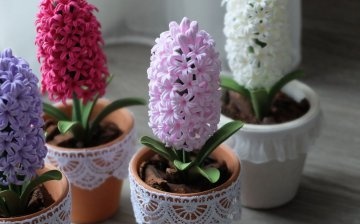

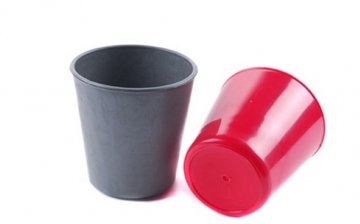

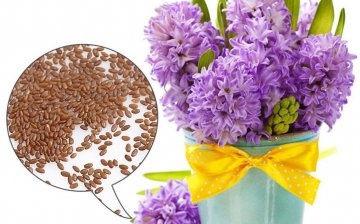
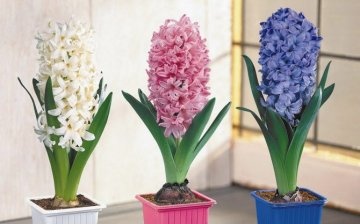
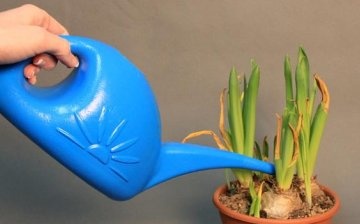
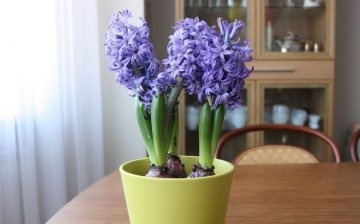
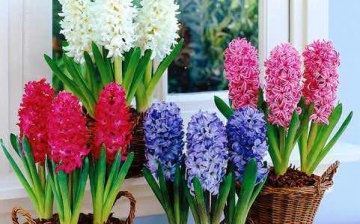









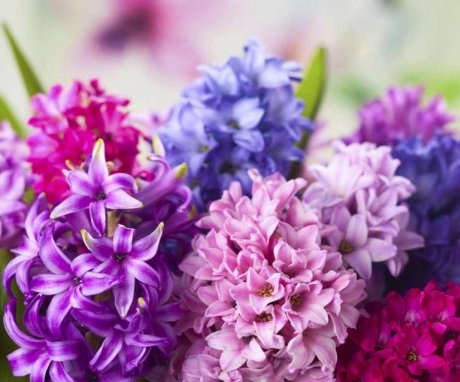

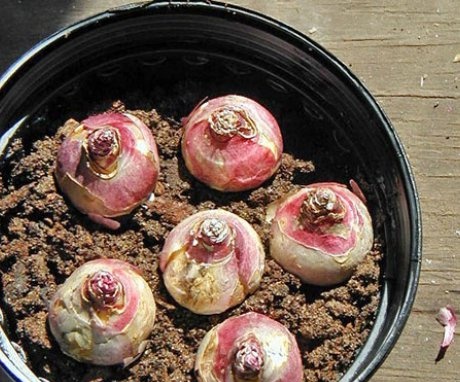
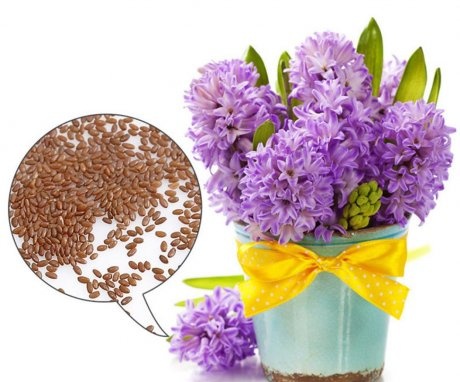

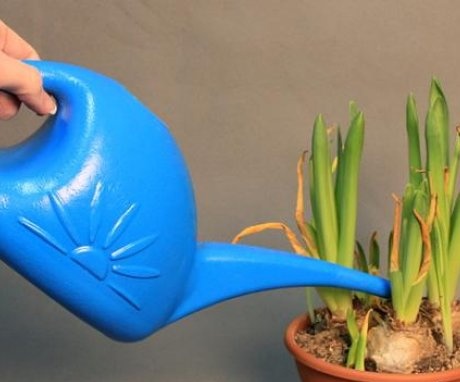

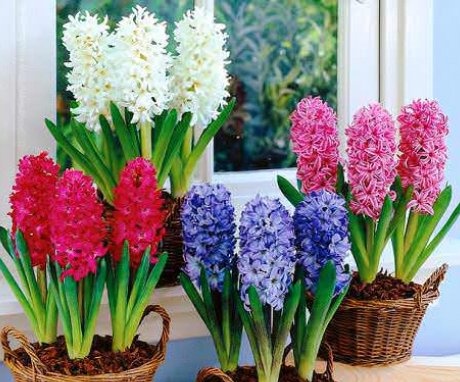
It seems to me that they once gave this flower, if I’m not mistaken, it smells very nice, but despite the fact that I tried and looked after this plant, for some reason it didn’t take root.
I love hyacinth because of its scent. Several times I tried to grow from a bulb, apparently, I did not follow all the rules, but there are a lot of them, as it turned out. The flower came out half-empty, and weak in appearance. And I wanted the same as in the photo - dense, all covered with flowers, large and healthy. I will try again, with new knowledge, I hope it will work!
I have already tried to drive tulips by March 8, I would like to try to grow hyacinth. Looks very nice on the photo! But, after reading the article, I realized that he is more whimsical to conditions than a tulip.